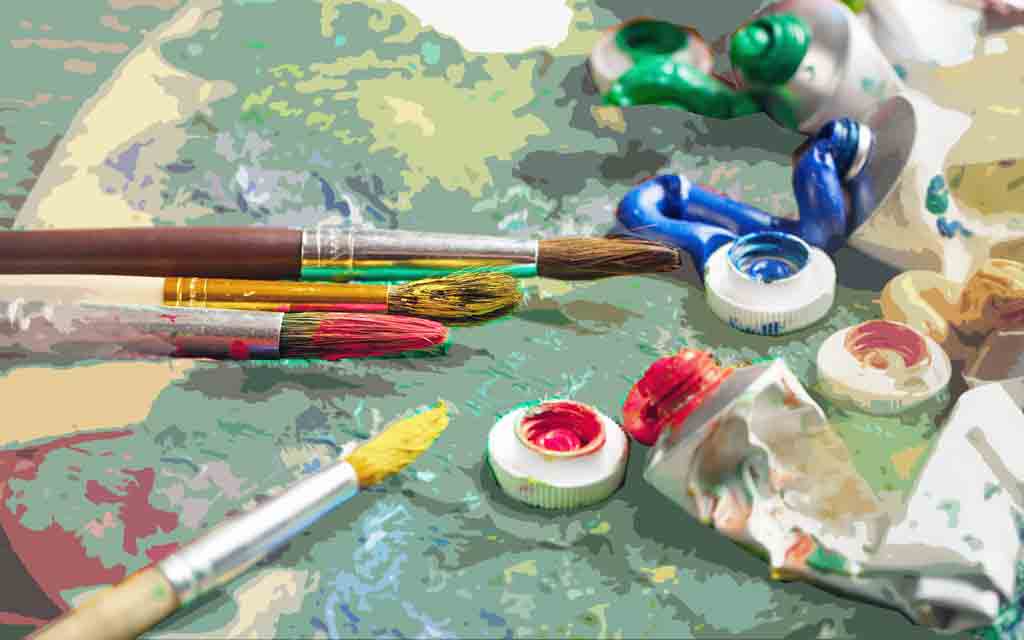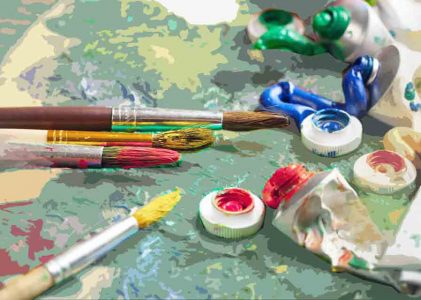The author investigates the influence of painting as the most impressive branch of visual arts on educational process of children. Properly organized painting lessons can also contribute to the development of well-educated, creative personalities who would better adapt to the rapidly changing socio-economic environment. It is difficult to achieve the implementation of this task using only traditional methods of teaching or training.
Painting Lessons for School-children as a Socialisation Means
Art is the daughter of freedom
Die Kunst ist eine Tochter der Freiheit
Friedrich Schiller:
Briefe über die ästhetische Erziehung des Menschen
(1795), 2. Brief
In society, any events are somehow significant; any phenomenon performs a particular role. However, social values have incorporated only those positive significant events and phenomena that serve human progress. Acting as a means of cultural transmission, education enables a person not only to adapt to the conditions of changing society, but also allows him or her to go beyond the boundaries of the specified social group, develop his or her own individuality and individuality to multiply the potential of the world civilization. In pedagogy, the theory of developmental learning acquires significant importance. It determines the nature of the design of the educational process, the organization of the cognitive activity of students during the performance of theoretical and practical assignments. Representing a scientifically organized multifaceted pedagogical system, the theory of developmental learning consists of elements with characteristics that include the notions of teaching and learning, located in a certain educational space.
The individual personality is formed under the influence of various factors, many of which act quite independently off the will and the consciousness of particular people.
These pertain to the biological nature of man or woman, social relations, social phenomena and situations, lifestyle, geographical environment, etc. However, there are also factors that to one degree or another depend on the will and consciousness of a person. These include ideology, the activities of the state, public institutions. Finally, there is a third group of factors that presuppose an organized development. All these factors are in continuous interaction.
Modern reality poses an important task for the educational system: to prepare a well-educated, creative person who could adapt to the rapidly changing socio-economic environment, rationally organizing his or her independent activity. It is extremely difficult to achieve the implementation of this task using only traditional methods of teaching or training. The introduction of innovative technologies into the educational process is a defining feature of modern education. The so-called “knowledge” pedagogy is being replaced by “ability” pedagogy and the “memory school” is successfully replaced by “school of thinking”. In fact, these are different methodological approaches to education, different concepts of creating an “educational field”; we are talking about different emphasis on what exactly should be developed in the student and how it should be done.
The school of “memory” is built on traditional foundations: the classroom system of education, the prevailing illustrative and explanatory method of teaching, the frontal form of organization of the educational space, reproductive type of control and questioning and other traditional characteristics. The target setting of this school is the formation of students’ knowledge, skills, and abilities. The leading type of activity that students learn within this school is reproduction. In the best case, within the framework of this school, the enrichment and development of the memory of the student takes place. The school of “thinking” focuses on the development of the personality of the trainee. Innovative methods are used here, which include: project activities; interactive training; integrated lessons; technology of critical thinking, tutoring support of students. A special case of personality development is the mastery by students of such mental operations as: synthesis, comparison, generalization, classification, induction, deduction, abstraction, etc.
The criterion for mastering mental operations is the work with concepts, and this work is regarded as a necessary condition for their formation, in which the organization of students’ educational activities in the classroom acquires special importance. The modern stage of pedagogical practice is the transition from information and explanatory learning technology to active teaching forms, aimed at development of a wide range of personal qualities of children. Not only the acquired knowledge becomes important, but also the ways of assimilation and processing of educational information, the development of cognitive forces and the creative potential of students.
In an effort to develop individuality, the technology in question does not single out any of the personality qualities focusing on their comprehensive development. Developmental training is aimed at developing the entire holistic set of individual qualities. Art is the strongest means to influence the attitude of an individual to the world around him or her through emotional channels. Reflecting reality in artistically generalized forms, in typically artistic images, art thereby acquaints the individual not only with the world in its various manifestations, but also with the modern attitude to this world. Both the knowledge about the world and the attitude to the world are given in specific individually unique images with universal, class, national and psychological features. Thus, various, most diverse properties and qualities of the surrounding reality are being relayed to an individual. In its influence, art is directly addressed entirely to the individual as a set of social relations, and not only to his or her aesthetic substantiality.
The implementation of art, as an educational tool, has its own objective reasons, based on the specific nature of art. It is the only phenomenon that can have a holistic effect on a person.
Communication with art brings a person to the world as such in its wholeness, in contrast to the sciences, where each of them considers a separate side of life, in contrast to morality, which is narrowed to “man to man” perspective, and in contrast to politics and law, which have an even narrower scope of showing human life in society. Through a work of art, a person perceives the world in its multi-coloured imagery joining and experiencing the infinity of humankind; this enables the individual to expand and deepen the individual experiences usually limited by time and space.
From the point of view of pedagogy, the fact that a work of art gives a person pleasure and joy sets her or him in an exceptional position, because this is a unique educational means that renders pupils pleasant moments of aesthetic enjoyment. The aesthetic pleasure received by a person at the moment of contact with the artistic image of the integral world presented in a work of art is the strongest mechanism of value orientations formed in a person.
The methodological position of the teacher in his understanding and evaluation of art is very important. Life, reflected in the artistic image, is the content of art. The presence of an artistic image is the essence of the work, which allows it to be attributed to the sphere of art. The path to people (information for the viewer-listener-reader) goes through the sensory channel, the most accessible channel of information. But the artistic image is by no means a natural imprint from reality. There is bound to be some generalization in it. It is a visual-sensual and therefore a kind of concrete-figurative phenomenon, which provides accessibility and the widest audience for the artist. A work of art adds something to life: it can expand properties of an object or phenomenon beautifying or harmonizing it and may be adding a touch of thoughtfulness. But this is a general approach to the works of art and it could narrow the communication with an artist; the abstract pieces of art require intellectual approach to perceive the reality the artist is referring to.
Painting, due to its specificity, occupies a special place in the system of implementation of art in the upbringing of children. Its peculiarity, from the point of view of pedagogy, lies in the clarity, “materialization” of the artistic image created by “another person”. Communication with the world through an artistic image is made on the basis of this “materialization”. For children, with their insufficient level of development and little experience of communicating with art, and hence a weak command of the language of art, this material expression becomes a visual help and creates a moment of transition from concrete-object thinking to thinking through an artistic image. Therefore, we believe that the approach to this type and genre of art should be assigned special importance in the educational process of students.
The visibility of the works of the main genres of painting, sculpture, graphics, and applied art is the necessary condition that provides for students an imperceptible transition from a concrete-real perception of art to an artistically generalized perception of life. Through colour, the child is drawn to beauty. Colour captivates, attracts, fascinates, strongly affects his condition, and shapes his mood. By conditioning the influence of form through colour, through paints, the work of painting begins to influence the content and thereby becomes the formative agent of reality. The availability of the form – colour – creates high prerequisites for educational influence. In terms of accessibility, we could put music as an art form next to the coloured depiction of life: it is akin to painting in its direct impact on a person.
However, painting deals with the colour that constantly surrounds the child, while music could be apprehended only when there is a rhythm and melody, that is, an ordered, organized series of sounds. Painting, at first glance, also deals only with an orderly chosen colour and is in some ways it is analogous to music. It is no coincidence that sometimes they say “symphony of colours” and “colourful scale of sound”. Nevertheless, it is nature that presents perfectly organized scales of colours and colour symphonies. The form of painting as an art form is natural and ingenuous. Taking paints, the child begins to draw very early – much earlier than he begins to sing, dance, sculpt, build, and compose poems. The form is borrowed by children directly from life by acquiring manifestations of colour of surrounding things and objects as well as of multi-coloured toys specially designed for them.
This peculiarity of painting, from the point of view of pedagogy, places it in a special position in some respects. Children easily enter into communication with painting; the volume of the depth of such communication is different and is due to both the development of children and their abilities. And this gives some preferential rights to painting in the system of artistic means of education. Drawing is one of the first manifestations of the child’s artistic activity: very early they begin to draw with a stick, chalk, finger, coal or a chunk of brick. Thus, they involuntarily and naturally enter the sphere of pictorial reflection of the world and themselves.
The artistic canvas is one of the objects of life reality for a schoolchild; it is a supplement to the life he is observing. Communication with painting for schoolchildren, who rarely travel, is a whole world lying outside their home and village.
Through communication with painting, children are able to see the hot countries of Africa, captivating Italy, the cold stiffness of England and the nearby harsh Siberia, and also review significant historical events: from the eruption of Vesuvius – to the Great Patriotic War (1941– 1945), perestroika and market relations after the Kazakhstan’s Independence. Their eyes, their vision are enriched by the experiences of human life. It is impossible, without joining poetry and painting, the diverse life of the whole of mankind to become a full-fledged citizen of the Earth. Painting expands the horizons of human life to extreme limits – the limits of its unlimited existence.
Ileskan Smanuly Smanov
Doctor of Pedagogical Sciences, Professor
Department of Psychology
Faculty of History and Pedagogy
E-mail: leshan49@mail.ru




